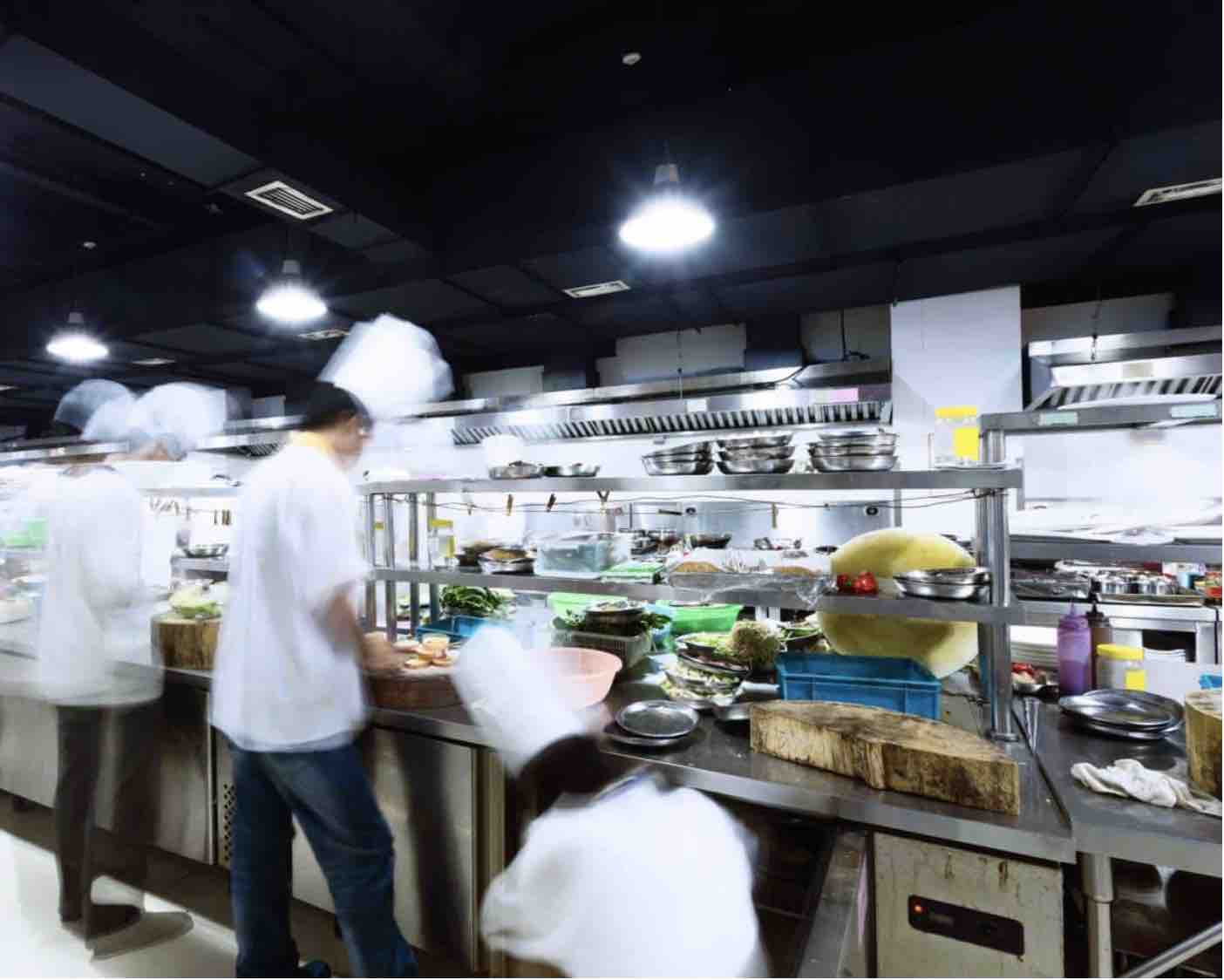Shelter-in-place orders, dine-in restrictions and diners’ hesitation to eat out have combined to prompt restaurants to shift their focus to takeout and delivery. Increased demand for food delivery had already boosted the growth of ghost kitchens, and the COVID-19 pandemic has escalated both the popularity and profitability of the model. Ghost kitchens cut the cost of real estate and labor by reducing the restaurant model to accommodate off-premise food sales.
The ghost kitchen boom is expected to extend beyond COVID-19, according to Technomic, a research strategic consulting group for the foodservice industry, which projects an increase in ghost kitchen food sales by a 25% each year for the next 5 years.
What is a ghost kitchen?
In the strictest sense of the term, a ghost kitchen is an off-premise facility for the preparation of food for delivery. Sometimes called a virtual restaurant, virtual kitchen or cloud kitchen, a ghost kitchen is a food-service business that serves customers exclusively through online orders.
Companies such as Cloud Kitchens and Kitchen United offer kitchen space for rent. Kitchen United, for example, provides a turnkey model, offering a code-safe kitchen with appliances and cooking implements. Cloud Kitchens offers a similar model. Other companies in the ghost kitchen space include Door Dash Kitchens and Virtual Kitchen Co.
For entrepreneurs, ghost kitchens offer the opportunity to experiment and launch their restaurant brands at minimal cost and less risk than opening a physical location. Ghost kitchens can be used to launch a new restaurant brand, or as a means for existing restaurant brands to expand their delivery range.
Existing restaurants are creating their own virtual off-premise kitchens, sometimes delivering food themselves to cut out the costs of a third-party delivery services, while others are embracing third-party delivery to increase their visibility. And other restaurant brands rent kitchen space and labor from existing brick-and-mortar restaurants to expand their delivery range. Restaurant365 customer Wow Bao recently announced it has partnered with operators in various cities to offer alternative sources of revenue by utilizing their space, equipment and personnel to serve prepared Wow Bao staples, while third-party delivery providers provide delivery of the meals to customers.
For restaurants that have already established physical locations, ghost kitchens can be a way to adapt to shifting trends, create a new revenue stream and expand delivery range. The focus of this blog post is to help existing restaurants launch their own ghost kitchens.
How a ghost kitchen works
Similarly to delivery at a brick and mortar restaurant, customers contact the ghost kitchen through the restaurant’s web site or mobile app or through a third-party delivery app. They can view the menu, place an order, and pay for their food with a credit card or bank transfer.
Once the customer places the order, the kitchen staff is notified, and food preparation begins. When the food is ready, a delivery driver employed by the restaurant or third-party delivery service transports the meal to the specified location. After the customer receives the order and the transaction is complete, funds are released to the business.
Size of U.S. market for online food delivery
According to Statista, a provider of market and consumer data, the market for online food delivery in the U.S. is experiencing explosive growth. Statista’s latest data indicates that:
- Revenue in the online food delivery segment is projected to reach $26,527m in 2020.
- Revenue is expected to show an annual growth rate (CAGR 2020-2024) of 5.1%, resulting in a projected market volume of $32,325m by 2024.
- The market’s largest segment is restaurant-to-consumer delivery with a projected market volume of $15,631m in 2020.
Pros and cons of creating a ghost kitchen to expand existing restaurant delivery
Before launching a ghost kitchen for your restaurant, there are several considerations. While there are many benefits, there are drawbacks as well.
Among the pros are minimal overhead cost, including lower real estate cost; the ability to meet the exploding demand for online delivery with the option to offer in-house delivery or multiple delivery services such as Grub Hub or DoorDash; relatively quick start up; and streamlined workflows as your sole focus is online delivery.
Additionally, a ghost kitchen offers the opportunity to capture a wider audience – both by geography and volume. In your dine-in location, you’re limited by a finite occupancy, which has been further reduced by social distancing guidelines. With a ghost kitchen, your sales are not limited by the number of seats at your restaurant. You also have a lower dependency on table turnover. Running a ghost restaurant eliminates this dependency because there are no dine-in customers.
One of the potential negative considerations include the difficulties of ensuring your delivered food offers the same quality as in your restaurant. You’ll have to package your meals for delivery, including packing sauces on the side and ensuring that your containers are insulated. You’ll also have to manage your online reputation even more diligently as your delivery business exists entirely online. Additionally, if you’re using third-party delivery apps, your customer service relies on the customer experience with the delivery service. A poor experience may lose your restaurant a customer forever. Another con is the cost of delivery. Third-party apps can take 30% of your delivery earnings and in-house delivery has its own costs, such as salaries, vehicle maintenance, gasoline and insurance.
How to set up and run your ghost kitchen
If you decide to launch a ghost kitchen for your existing restaurant business, these tips will help you set up and run your new business venture.
1. Optimize Your Menu for Delivery
You must focus on prep time, plus food temperature, quality, and taste. Consequently simplicity, versatility of ingredients, and consistency are key. Time and temperature are huge issues for food quality and are the biggest considerations when developing your ghost kitchen concept. Keep your food costs low by offering a limited menu with items that use similar ingredients and preparation methods.
2. Select a Location
The greatest benefit of ghost kitchens is that they can be located virtually anywhere. Consequently, you don’t need to pay top dollar for real estate or worry about signage and drive-by/walk-in customers. All you need is kitchen space in a location that expands your delivery range. Focus on areas where your dine-in customers already exist so that you have an initial customer base for your delivery. If you choose a location beyond your existing customers’ geographic location, be prepared to build your brand in the new area.
3. Choose Your Delivery Method
One of the biggest considerations when launching a ghost kitchen is choosing a delivery method. Choosing between in-house delivery, third-party delivery apps or a combination requires an understanding of related costs.
Third-party delivery apps such as DoorDash, Grubhub, Postmates and Uber Eats charge a commission in exchange for providing one of the most critical aspects of your ghost kitchen’s success. While the fees might be steep, you are leveraging proven technology platforms to connect with customers, receive online orders, and provide reliable delivery fulfillment. POS providers Toast and Square have recently launched their own delivery services, at costs they say are lower than some of the more established delivery providers.
If you choose to handle delivery in house to avoid third-party delivery fees and create work for existing employees during restaurant restrictions, you’ll have to reallocate your labor and add drivers into your scheduling. You’ll also need to check with your insurance carrier to ensure that you’re covered for off-premise activity.
4. Factor Delivery Costs into Your Ghost Kitchen Menu Prices
While your ghost kitchen is saving money on real estate and front-of-house employees that you’re paying at your physical restaurants, those savings are offset by delivery costs – whether you handle it in house or through a third-party delivery app.
Include a portion of the delivery costs in your food prices to ensure your ghost kitchen makes a profit.
5. Ensure That Your Ghost Kitchen Meets Health and Safety Requirements
Your local health department will want to visit your new space before you become operational. The regulator will review your food storage areas, production methods, and general flows that take into account standard operating procedures for food preparation. You will need to write these out for your final inspection and licensing. The regulator will also want to walk through your menu and know what third-party service providers you plan to use. Ensure your “person-in-charge” has an up-to-date ServSafe Food Manager certification. As required by the Food and Drug Administration, every restaurant (and ghost kitchen) must have a person in charge on site during operating hours.
6. Experiment with New Menu Items or Concepts
One of the benefits of ghost kitchens is the ability to experiment with new menu items or concepts as you can control your available menu live, so adding a special mid-day or removing an item because of ingredient shortage is not as detrimental. This is a great opportunity for culinary teams to explore and experiment in ways that on-premise teams cannot due to the overhead.
7. Staff Your Ghost Kitchen
As if restaurant staffing wasn’t already one of your greatest challenges, the COVID-19 pandemic has brought it to critical levels. Many employees do not feel safe coming back to their restaurant jobs because they don’t feel safe.
Fortunately, in many ghost kitchens, there are only a few staff members. That may alleviate the fears for many of your potential employees.
When recruiting for your ghost kitchen, advertise your job openings where job seekers are searching. Consider using an applicant tracking solution that automatically cross posts your job listings across various job boards and social media channels, enabling you to easily connect with a broader range and more qualified candidates. You might also consider using a solution that engages with your top candidates that meets their preferred method of communication, for example, since Millennial and Generation Z applicants typically have a strong preference for text message communication, use a solution that features automated text messaging for you to quickly engage and respond to top candidates.
8. Optimize Scheduling for Your Ghost Kitchen
The ghost kitchen streamlines your workflows as your total focus is preparing and packaging meals for delivery. Still, effective scheduling is critical to keeping your labor costs low. If you’re handling delivery in house, you’ll also need to factor drivers into your scheduling.
As with scheduling for your brick and mortar location, you’ll need to schedule your ghost kitchen employees well in advance, create a process and deadline for accepting employee scheduling requests, and try to give your staff two consecutive days off per week.
You can save time by using restaurant scheduling software. With restaurant scheduling software, you can reuse a schedule or create templates for future schedules, saving time on a weekly basis. Combined with a mobile app for employees, your staff can access an up-to-date schedule from anywhere.
9. Control Inventory for Your Virtual Kitchen
Managing your restaurant inventory helps you prevent waste, lower your food cost, and increase your bottom line. Inventory management is especially critical when operating a ghost kitchen. Staying on top of your off-premise food inventory is one of the most important things you can do to ensure your kitchen becomes a thriving enterprise.
Initially, you’ll want to lower stock inventory. When you determined your off-premise menu items, ideally you created a limited menu that enables you to lower your food cost and adjust to the limitations of delivery. Just as in your on-premise operation, it is wise to examine inventory costs and food waste to increase profit margin on each dish.
Add a daily special that uses surplus ingredients in ways that minimize your food waste and incorporate ingredients into existing dishes before they go bad. Making the most out of what is already in your kitchens helps lower your food cost.
Forecasting your demand based on recent sales data can be a powerful tool to help you manage inventory. An accurate forecast can help you make optimal ordering decisions, covering your baseline demand while minimizing the food left on your shelf that may be wasted.
Forecasting for your first week or two may be challenging, however, if your restaurant has been open for takeout/delivery/curbside during restaurant restrictions, start your forecast with those revenue centers. Study the trend of your takeout and delivery business over the past few months and use those numbers for your initial ghost kitchen forecast.
For more inventory management tips, read the blog post, Managing Restaurant Food Inventory for Off-Premise Channels.
10. Market Your New Channel
The success of your ghost kitchen will be highly dependent on your marketing. Create a plan that pushes your brand to online customers on an array of forums. Use social media for specials and promotions and post stunning food photos on your website and Instagram to attract customers. Maintain a complete and current Google My Business profile and Yelp profile, and encourage Yelp reviews. Promote “user-generated content” – those great pictures of your food that your customers post on social media. It is a valuable kind of free advertising. Also use your email database to promote your new kitchen.
For more marketing ideas, read the blog post, 13 Restaurant Marketing Ideas and Tips for Driving More Customers.
11. Use Data to Improve Your Ghost Kitchen’s Profit Margin
One of the greatest advantages of a ghost kitchen is that it enables you to be flexible. Use your restaurant data to determine what is selling, where it is selling, and how often and when it is selling. Perhaps the pizzas are selling at lunch near the beach and salads are your best sellers in the suburbs after 6:00 p.m. Consider offering higher profit margin options on these items, such as lobster on your salads to increase revenue per order and creating options that encourage customers to upgrade their meal to boost check averages without adding time and labor in the kitchen.
Keep an eye on internet reviews. Are your customers complaining about soggy burgers? Consider changing your packaging or keeping the spread on the side. Pay special attention to comments on delivery speed, food quality and menu items customers like best. This will help you focus on what’s working and will help you tailor your menu and operations accordingly.
12. Track Profitability of Delivery Services
When adding a ghost kitchen to your existing restaurant business model, it’s important that you properly record these sales in your accounting system. If you’re offering third-party delivery in both your physical location and your ghost kitchen, you should treat your ghost kitchen as a separate location and create a separate a AR account for each third-party delivery service. This will allow you to track the profit margin of each delivery service as margins may vary between your physical location and your ghost kitchen. Armed with this information, you can make informed decisions about which delivery services to use going forward. Using an AR account to record delivery services also allows you to reconcile your third-party delivery expected revenue at the end of each week.
Great NH Restaurants launches a ghost kitchen
In June 2020, Restaurant365 customer Great NH Restaurants (T-BONES, CJ’s Great West Grill, Copper Door) unveiled the state of New Hampshire’s first ghost kitchen. Great NH launched DingDongDeliver.com, a specialty service that is designed exclusively to meet the growing demand for quality food delivered directly to local area homes and businesses.
The ghost kitchen features a variety of popular brand related items (such as T-BONES Chicken Pot Pie), as well as some packaged dinner options that only need reheating. DingDongDeliver.com also features Premium Reserve steaks, fresh ground burgers and marinated chicken for those who prefer to cook at home.
In its first month of business, the ghost kitchen has enjoyed success, according to Great NH Restaurants’ CEO Tom Boucher. “So far, it’s been very well received, and it is more profitable than most of our restaurants. With very low rent and no front-of-the-house labor (wait staff, host, manager) that has helped with return on sales. We will be branching out and marketing in our restaurants where guests can order and pick up directly at the restaurant on a specific day of the week. We will reach 10X more potential customers this way,” said Boucher.
When asked what advice he would give to other restaurant operators considering launching their own ghost kitchens, Boucher stated, “Choose a location that is very affordable. Because your brand only lives online, you don’t need a high traffic, high visibility location. Your food and your online brand are what matters.”
Conclusion
Opening a ghost kitchen for your existing restaurant business can create a new revenue stream for your business, expand your delivery range and help you adapt to consumer trends, but it’s not without its own drawbacks.
If you’re considering launching a ghost kitchen, you must make tough choices about location, menu offerings, and staffing, while making financial projections for the new venture. Understanding the complete picture is critical to the success of your ghost kitchen. Having accurate data informing the critical decisions you make about your business is more important now than ever.
If you would like to easily track data and gain insight into your operations, consider a comprehensive, restaurant-specific management solution. Restaurant365 incorporates restaurant accounting software and restaurant operations software into an all-in-one, cloud-based platform. It includes tools for financial reporting, operational reporting, for inventory control, scheduling, and more. For more information, schedule a free demo.



